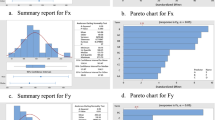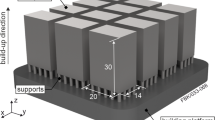Abstract
In view of the lack of researches on the influence of micro textures on the cutting performance of milling cutters, this paper studies the cutting performance of the micro-textured ball-end milling cutter, taking the distance from the cutting edge and the offset angle as the influencing factors, and through the comparative test with non-texture cutters, studies the cutting performance and formation of the chip. The results showed that when micro textures are close to the cutting edge, the milling force is larger, while the offset angle had no significant effects on the milling force. The optimized micro-textured parameters are 120 µm and 0.3°. Compared with the non-texture cutter, the micro-textured cutter had better effects of anti-wear and anti-friction, as well as surface quality of the workpiece. The deformation is more serious when the chip passes the rake face. This paper has some guiding significance for the preliminary design of micro-textured cutters.
Similar content being viewed by others
Abbreviations
- L:
-
The distance from cutting edge
- θi :
-
The initial offset angle
- Vc :
-
Cutting speed
- f z :
-
The feed
- a p :
-
Back engagement
- a e :
-
Working engagement
References
W. Grzesik, Advanced Machining Processes of Metallic Materials, Elsevier (2008).
Y. Shucai et al., Finite element simulation of titanium alloys prepared by micro textured ball milling cutter, Journal of Shenyang University of Technology, 37 (5) (2015) 530–535.
Biting, Structural design of micro-texture self-lubricating cutting cutters, Master’s Thesis, Shandong University (2012).
L. Yuanqiang, D. Jianxin, Z. houming and Y. Bin, Dry cutting performance of 0Cr18Ni9 austenitic stainless steel with micro texture self-lubricating tool, Mechanical Engineering Materials, 3 (2015).
W. Ze, Research on dry cutting cutters with dual effects of micro-texture self-lubrication and oscillating heat pipe self-cooling, Master’s Thesis, Shandong University (2013).
C. Chen, Application of surface functional structure in titanium alloys cutting, Master’s Thesis, Huazhong University of Science and Technology (2013).
L. **n, Wear characteristics of surface micro-texture WC-10Ni_3Al cutter for cutting Ti6Al4V, Master’s Thesis, South China University of Technology (2015).
J. Ma, N. H. Duong and S. Lei, 3D numerical investigation of the performance of microgroove textured cutting cutter in dry machining of Ti-6Al-4V, The International Journal of Advanced Manufacturing Technology, 79 (5–8 (2015) 1313–1323.
Y. Feng, J. Zhang, L. Wang, W. Zhang, Y. Tian and X. Kong, Fabrication techniques and cutting performance of micro-textured self-lubricating ceramic cutting tools by in-situ forming of Al2O3-TiC, International Journal of Refractory Metals and Hard Materials (2017) 68.
D. M. Kim, V. K. Bajpai, B. H. Kim and H. W. Park, Finite element modeling of hard turning process via a micro-textured tool, The International Journal of Advanced Manufacturing Technology, 78 (9) (2015) 1393–1405.
Z. Yongkang, Laser Processing Technology, Bei**g Chemical Industry Press (2004) 4–6.
F. Chuang, Research on wear of carbide ball end milling cutter based on titanium alloys cutting, Master’s Thesis, Harbin University of Science and Engineering (2015).
S. Yang, T. Wang, W. Ren and S. Su, Micro-texture design criteria for cemented carbide ball-end milling cutters, J. of Mechanical Science and Technology, 34 (4) (2020) 127–136.
T. **n, Research on accurate distribution design and parameter optimization of micro texture of ball end milling cutter, Master’s Thesis, Harbin University of Science and Technology (2019).
Y. Shucai, Z. Yongzhi, Z. Yuhua, Tongxin and L. Weiwei, Prediction of surface roughness of titanium alloys milled by microstructure ball end milling cutter, Journal of Harbin University of Science and Technology, 22 (3) (2017) 141–146.
Acknowledgments
This work was supported by the National Natural Science Foundation of China (51875144).
Author information
Authors and Affiliations
Corresponding author
Additional information
**n Tong is a Lecturer of the School of Mechanical Engineering, Harbin University of Science and Technology, Heilongjiang, China. She received her Eng.D. in Mechanical Engineering from Harbin University of Science and Technology. Her research interests include cutting mecha-nism, cutting tool and micro textures.
Rights and permissions
About this article
Cite this article
Tong, X., Yu, S. Influence of micro-textured parameters on cutting performance and chip formation of milling Ti6Al4V. J Mech Sci Technol 34, 3767–3774 (2020). https://doi.org/10.1007/s12206-020-0828-9
Received:
Revised:
Accepted:
Published:
Issue Date:
DOI: https://doi.org/10.1007/s12206-020-0828-9




